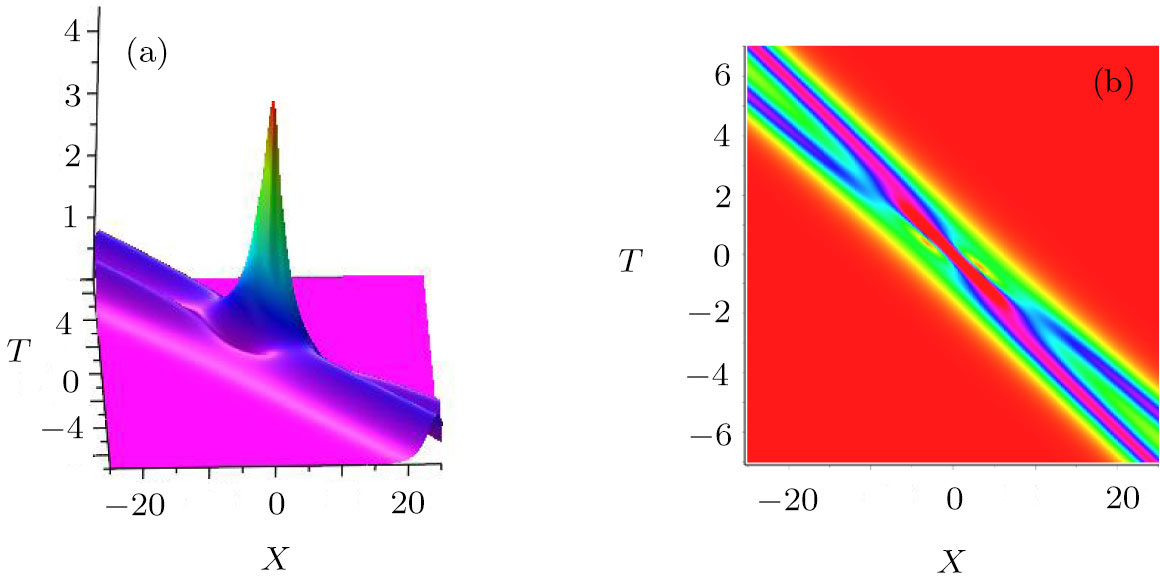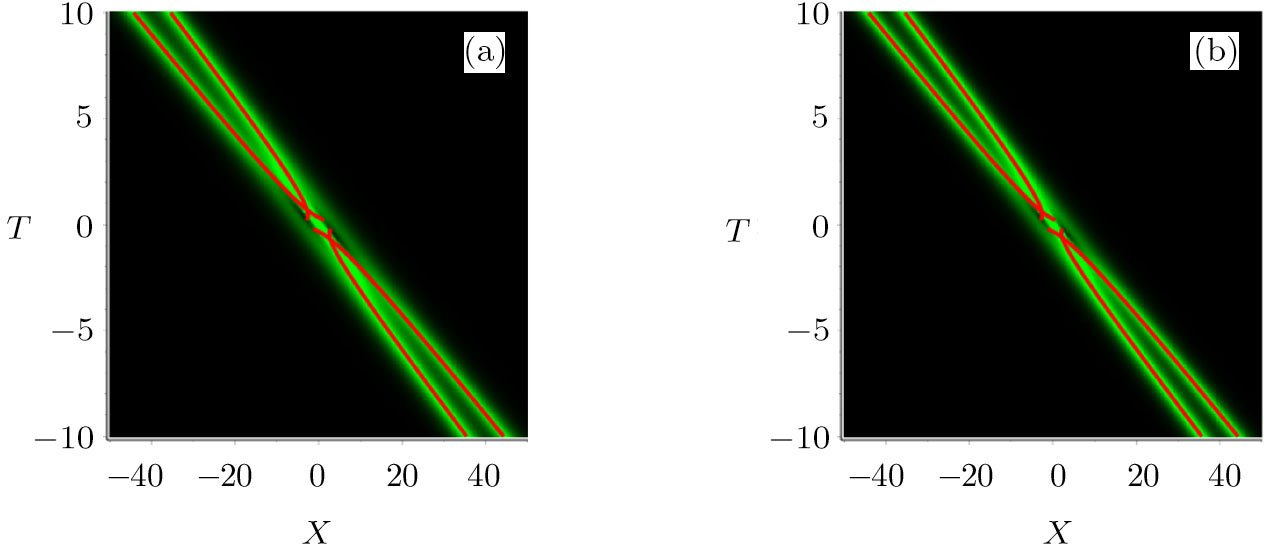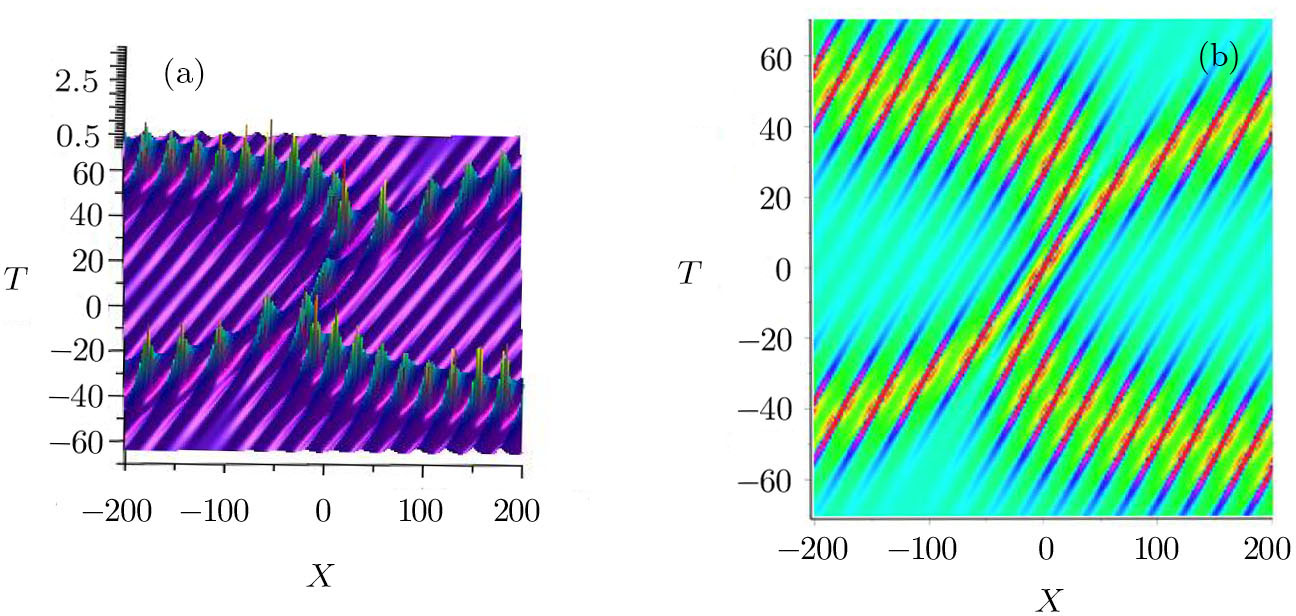† Corresponding author. E-mail:
Supported by the National Natural Science Foundation of China under Grant No. 11671219, the K. C. Wong Magna Fund in Ningbo University
We discuss a modified Wadati-Konno-Ichikawa (mWKI) equation, which is equivalent to the WKI equation by a hodograph transformation. The explicit formula of degenerated solution of mWKI equation is provided by using degenerate Darboux transformation with respect to the eigenvalues, which yields two kinds of smooth solutions possessing the vanishing and nonvanishing boundary conditions respectively. In particular, a method for the decomposition of modulus square is operated to the positon solution, and the approximate orbits before and after collision of positon solutions are displayed explicitly.
Wadati, Konno, and Ichikawa (WKI) derived two highly nontrivial nonlinear equations in 1979.[1] These equations are the WKI-I equation







The mWKI equation is a very special equation in integrable systems, because it has bright solitons from vacuum for defocusing system (r = q*, asterisk denoting complex conjugate) and focusing system (r = −q*) simultaneously, which is never displayed until the appearance of our recent work.[4] In addition, the soliton solution, breather solution and rogue wave solutions[4] of the mWKI equation are also constructed by the Darboux transformation (DT). Here, we will study the mWKI equation with degenerated DT[5] and give the formula of N-th order degenerated solution, which yields positon solution and breather-position (b-positon) solution.
Positon solution was first found by Matveev in 1992 for Korteweg de Vries (KdV) equation when the spectral parameters are approaching the same value,[6] then it was quickly extended to the sine-Gordon equation,[7–8] the modified KdV equation,[9–10] sinh-Gordon equation,[11] and so on. Similar to the soliton solution, positon solution is a fundamental solution generated from zero background for nonlinear integrable equation, and exhibits many interesting properties. Even though soliton and positon solutions are different, they also have connections,[12] In general, positon solutions are viewed as long-range analogues of solitons and they are slowly decreasing, oscillating solutions.[13] In addition, relationship between positon solution and breather solution is shown in Ref. [12].
The positon solution belongs to the “Hirota family” and can be derived from the standard second order soliton by a proper limiting procedure.[14] The detailed derivation of a second order positon solution of the KdV equation from a second order soliton solution has been given by Kurasov. Different from the soliton solutions, two positons remain unchanged after mutual collision.[15–16] Since the positon solutions are mainly found in the real-valued equations,[17–19] and these solutions are singular. The mWKI as a complex-valued physical model is deserved to be further studied for the following reasons: (i) Are there smooth positon solutions in the complex-valued equation like the mWKI? (ii) How to calculate the trajectories before and after collisions of positon solutions? (iii) The WKI equation admits saturable nonlinearity, and the b-positon solutions are useful for generating the rogue waves in optics,[20] so the study about b-positon solution of the mWKI has potential value in optics.
The Lax pair of the WKI-I equation[1] is given by



Similar to the determinant representation of the n-fold DT for the nonlinear Schrödinger equation,[21–22] the n-fold DT of the mWKI equation has also been given in a determinant form.[4] For convenience, we display the formula of N-th order solution generated by the n-fold DT and reduction condition in appendix.
Set “seed” solution r = q = 0, then ζ = 1. Furthermore, select λk = ξk + iηk, the eigenfunction associated with the “seed” solution is given by


According to reduction condition and the formula of N-th order solution given in Eq. (

Similar to Ref. [6], when eigenvalues also go to the same value in formulas (
Then, from the formula given in Theorem 



The profile of the fundamental positon solution is displayed in Fig.




 | Fig. 1 (Color online) The evolution of the fundamental positon solution |q2−p| for the mWKI equation with ξ1 = 1 and η1 = 0.35. |
The result given in Theorem
Moreover, according to the above decomposition method, we can get the similar results for the higher order positon solutions. In order to further show the validity of this method, we provide another example.
We are now in a position to study the solution of the mWKI equation with a nonvanishing boundary condition. Let a nonzero “seed” solution



This paper mainly discusses the mWKI equation, which is equivalent to the WKI-I equation by a hodograph transformation. The determinant representation of the N-th order smooth degenerated solution for the mWKI is presented in Theorem
| [1] | |
| [2] | |
| [3] | |
| [4] | |
| [5] | |
| [6] | |
| [7] | |
| [8] | |
| [9] | |
| [10] | |
| [11] | |
| [12] | |
| [13] | |
| [14] | |
| [15] | |
| [16] | |
| [17] | |
| [18] | |
| [19] | |
| [20] | |
| [21] | |
| [22] |



